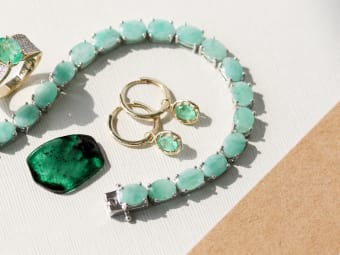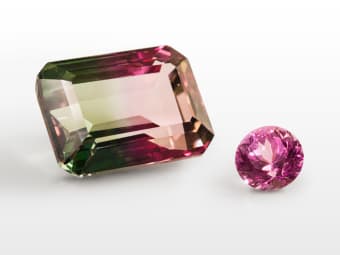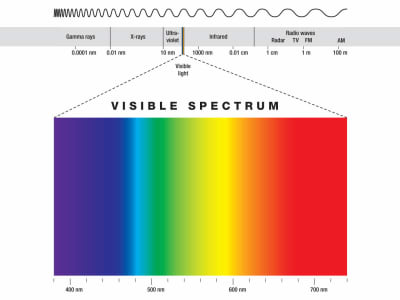Have you ever seen a vivid blue diamond, or possibly a radiant pink sapphire? Gemstone colors can be amazing, yet most people are unable to explain why we see these rich, vibrant hues. In effect, what we perceive is the total effect of the residual light from the object we are viewing.
Our perception of color is due in part to three basic factors: the object itself, the type of light in which the object is viewed and our eyes.

Gemstone Color and the Eye of the Beholder
Most of us know that light is composed of all the colors of the rainbow, as evidenced by nature's spectacular display after a rainstorm. Our eye is the real key to this phenomenon.
In an individual with normal sight, there is a series of rod- and cone-like structures spread out over a light sensitive membrane called the retina. Of the two, the cones determine our visual acuity and sensitivity to color. It is believed that there are three varieties of cones; each sensitive to a different range of the total white light spectrum. In the case of color blindness, one or more of these receptors is either defective or nonfunctional.
Light Absorption in Gemstone Color
In a simple case like a piece of red glass, nearly all the blue, green and yellow rays are absorbed, while the red rays are freely transmitted. Therefore, we see the color red. Simple, right? With gemstone colors, there is a much higher level of complexity.
Light hitting a gemstone may be reflected and dispersed internally. In addition, some wavelengths of white light may interact with the atomic structure of the stone, changing its state and altering what is absorbed and emitted. Sometimes inclusions may interfere with the light entering the gem and cause it to become scattered or diffracted. In many stones, a combination of factors may be responsible for the gemstone colors we ultimately perceive.
Dominant and Secondary Colors in Gemstones
If your gem is ROYGBV (red-orange-yellow-green-blue-violet) then it’s easy to identify the gemstone’s color, but what if it’s somewhere in between? After all, gemstones can occur in every imaginable color across a vast variety of types. Few gemstones exhibit pure hues and those that do are highly prized.
Even gemstones such as ruby, a color gemstone renowned for some of the finest reds in nature, will have secondary colors. Ruby quite often shows as orangeish or purple-red.
When gemstones exhibit multiple colors, one color is often dominant. In this case, we state the modifying color first and the dominant gemstone color last. For example, most aquamarine, a blue variety of beryl, show a greenish blue color. If both colors are equal, we would state the gemstone color is blue-green or green-blue to show they are present in equal quantity.
When identifying or grading the color of gemstones, it is best to use only the color names and avoid using descriptors like royal, cornflower, lemon or pigeon’s blood as these words all refer to a range of gemstone colors rather than a specific hue.
It is best to use only the color names and avoid using descriptors... as these words all refer to a range of gemstone colors rather than a specific hue.
Gemstone Color Intensity
Some gemstone colors may also be modified by using the terms grayish or brownish before the color. These adjectives are describing the intensity of the hue such as how strong or weak the color is. Cool colors such as green, blue and violet will tend to be grayish when their saturation is less than moderately strong. Likewise, warm colors such as purple, red, orange and yellow will tend to be brownish when they have a less than moderate saturation.
With a stronger than moderate saturation, gemstone colors are usually described as strong, intense or vivid. Often colors will also be referred to as light or dark to describe the tone. Very light or very dark gemstones will also tend to have a lower saturation and appear grayish or brownish.

Gemstone Color Treatments and Enhancements
Enhancing and improving the colors of a gemstone is possible through several means. Heat treatment, radiation, oiling and filling are the three primary means through which gemstones get enhanced colors. A large percentage of gemstones on the market are treated in some way or another, in order to help the color, clarity and even the durability of a gemstone. Gemstones that are treated are often natural stones, which receive enhancements through these processes, and are then sold to jewelers and gemstone collectors.
Common gemstones to receive treatment include members of the corundum family such as sapphire and ruby, blue topaz, green diamond, tanzanite and many more. Heat treatments in corundum can enhance the color of the stone, as well as adding or removing asterisms, a star-shaped inclusion, in the gemstone. Combining heat and oiling treatments can magnify the deep green color of an emerald. Enhancement via radiation opens up a world of new possibilities for colors. Blue topaz is rarely found because it needs radiation in order to achieve its coloration. Thankfully, laboratories can manually introduce whatever a preexisting gemstone needs to complete its color transformation. Some lab-heated gemstones, such as tanzanite, are near impossible to distinguish from naturally occurring violet-blue tanzanite.
Identifying Colored Gemstones For Yourself
Now, take a look around you or a go grab a tray of your favorite gemstones and have fun naming all the colors you see. So the next time you see a vibrant color gemstone, marvel at nature's amazing gift to the human race. The beauty of a gemstone is more than skin deep and considerably more complex.

